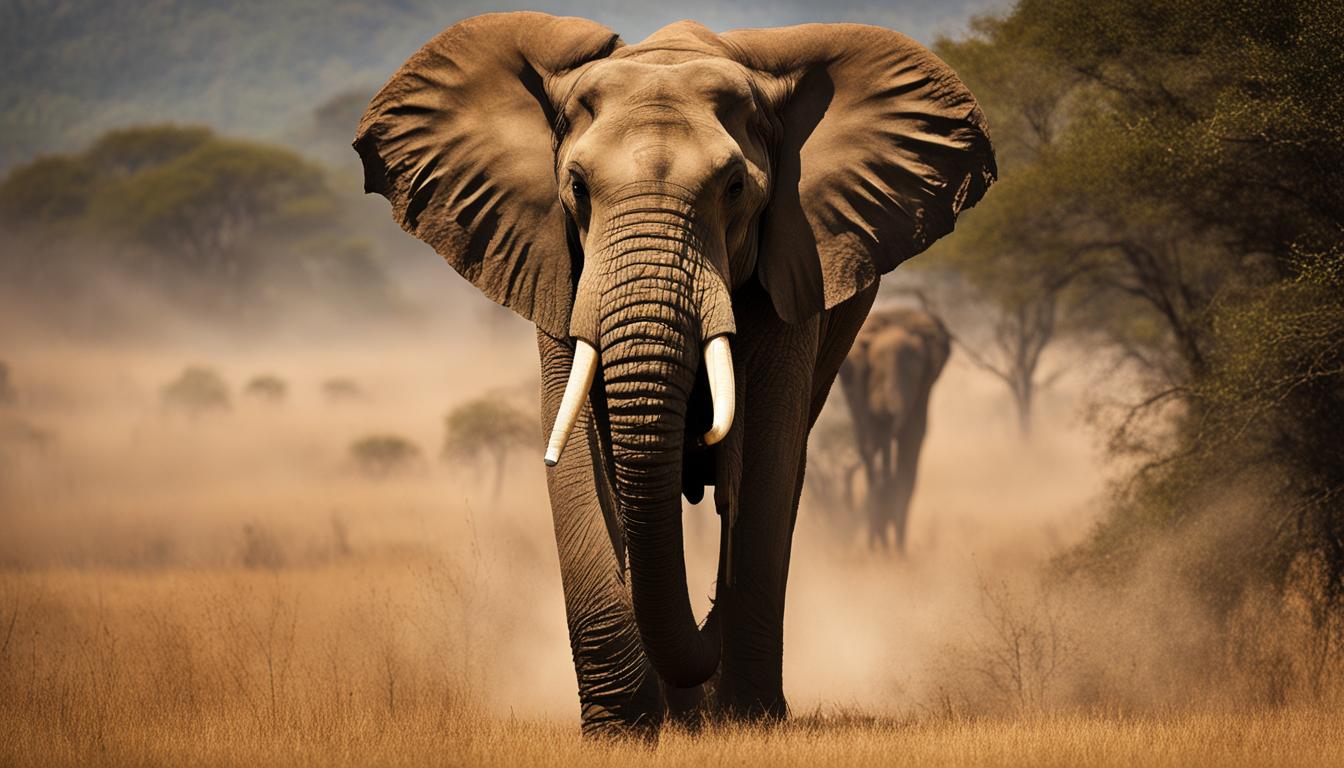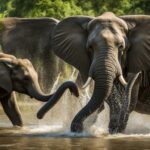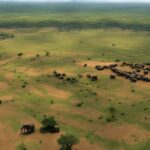Have you ever wondered how long elephants live in the wild? Understanding the lifespan of these majestic creatures is essential for their conservation and well-being. In this article, we will explore the average elephant lifespan, factors that affect their longevity, and the impact of captivity on their overall health. Let’s dive in!
But first, let’s take a moment to appreciate the beauty of these incredible creatures.
Factors Affecting Elephant Lifespan
Several factors can influence the lifespan of an elephant. These factors include disease and health issues, such as anthrax, tuberculosis, trunk paralysis, and elephant pox. Elephants are also susceptible to diseases spread by mosquitoes and common ailments such as constipation and pneumonia.
Habitat loss and fragmentation, as well as poaching for ivory, are major threats to elephant populations, resulting in decreased breeding opportunities and increased human-elephant conflict. These external factors significantly affect the lifespan of elephants in the wild. Research has shown that elephants in captive environments also experience additional challenges.
Elephants in captivity face a lack of socialization, exercise, and freedom from abuse, which can impact their overall wellbeing and lifespan. The restricted space and inability to engage in natural behaviors can lead to stress, obesity, and other health issues. These factors collectively contribute to a shorter lifespan for elephants living in captivity compared to their counterparts in the wild.
Impact of Disease and Habitat Loss
Diseases such as tuberculosis and anthrax can severely impact the health and lifespan of elephants. Additionally, habitat loss and fragmentation disrupt the natural environment, limiting food and water sources, and increasing the likelihood of conflicts with humans. These factors further decrease the average lifespan of elephants in the wild.
| Factors | Effects |
|---|---|
| Disease | Decreased lifespan due to tuberculosis, anthrax, and other diseases |
| Habitat loss | Reduced access to food and water sources, increased human conflict |
| Poaching | Decreased breeding opportunities, high mortality rates |
It is important to address these factors through conservation efforts to protect elephants and ensure their longevity. By focusing on disease prevention, habitat preservation, and anti-poaching initiatives, we can help secure a brighter future for these magnificent creatures.
Lifespan Comparison – Wild vs. Captivity
When it comes to the lifespan of elephants, there is a stark contrast between those living in the wild and those in captivity. Wild elephants typically live 60 to 70 years, while elephants in captivity have significantly shorter lifespans, often dying before they reach 40. This stark difference raises important questions about the impact of captivity on elephant health and wellbeing.
In the wild, elephants have the freedom to roam vast territories, live in close-knit family groups, and engage in natural behaviors. This lifestyle provides them with the necessary physical and social stimulation to thrive. However, in captivity, elephants are often confined to smaller spaces, deprived of their natural social structures, and limited in their ability to engage in natural behaviors. These restrictions can have detrimental effects on their physical and mental health, leading to shortened lifespans.
Furthermore, the conditions of captivity contribute to the development of chronic health problems in elephants. Captive elephants are prone to diseases such as tuberculosis, arthritis, and foot abscesses, which can significantly impact their overall wellbeing. The lack of space for exercise, inadequate socialization, and the use of abusive training methods further exacerbate these health issues, leading to premature death.
| Type of Elephant | Wild Lifespan | Captive Lifespan |
|---|---|---|
| African Elephant | 60-70 years | Shorter than 40 years |
| Asian Elephant | 60-70 years | Shorter than 40 years |
These findings highlight the urgent need for conservation efforts to protect elephants in their natural habitats and to enforce ethical standards in captive facilities. By prioritizing the preservation of their natural behaviors, promoting adequate space and socialization, and eliminating abusive practices, we can help ensure the long and healthy lives of these magnificent creatures.
The Impact of Captivity on Elephant Wellbeing
The confinement and limitations imposed by captivity have a profound impact on the wellbeing of elephants. In the wild, elephants live in large family units, forming strong social bonds and engaging in complex social interactions. However, elephants in captivity are often isolated from their natural social structures, leading to loneliness and psychological distress.
The physical well-being of captive elephants is also compromised. Lack of space for exercise and unnatural flooring surfaces contribute to the development of chronic health issues such as arthritis and foot problems. Additionally, the use of abusive training methods, including beatings and painful techniques, not only cause physical harm but also result in psychological trauma.
It is clear that captivity is not suitable for elephants, and their lifespans are significantly reduced as a result. To ensure the wellbeing and longevity of these magnificent creatures, we must prioritize their protection in the wild and support initiatives that promote ethical practices in captive facilities.
Impact of Captivity on Elephant Wellbeing
Life in captivity is detrimental to the wellbeing of elephants. These magnificent creatures are deprived of their basic needs, including socialization and exercise, which have a profound impact on their overall health and lifespan. In the wild, elephants live in large family units, forming deep social bonds and constant companionship. However, in captivity, they are often kept alone or in small, artificial social units, denying them the opportunity for meaningful social interactions.
The lack of socialization in captivity has severe consequences for elephants. It leads to increased stress, anxiety, and even depression, affecting their mental and emotional wellbeing. Elephants in captivity also suffer from inadequate exercise. They are often chained for long periods and have limited space to move, which contributes to physical health problems such as arthritis and foot abscesses. These chronic health issues can shorten their lifespan and significantly reduce their quality of life.
“The welfare of elephants in captivity is a growing concern. These animals are highly intelligent and social beings, and the restrictive conditions of captivity can have devastating effects on their physical and mental health.” – Dr. Jane Goodall
In addition to the lack of socialization and exercise, elephants in captivity are often subjected to abuse and cruel training methods. They are routinely beaten, shocked, and subjected to painful practices to force them to perform unnatural behaviors for entertainment purposes. This abuse not only causes physical harm but also psychological trauma, further compromising their overall wellbeing.
Table: Comparison of Elephant Wellbeing in the Wild and in Captivity
| Wild | Captivity | |
|---|---|---|
| Socialization | Thriving in large family units with constant companionship | Isolated or limited interaction with other elephants |
| Exercise | Ample space to roam and engage in natural behaviors | Restricted movement, often chained for long periods |
| Abuse | Protected from physical and psychological harm | Routinely subjected to abusive training methods |
It is crucial to address the impact of captivity on elephant wellbeing and prioritize their natural habitat, socialization, exercise, and freedom from abuse. By implementing conservation strategies that prioritize these factors, we can ensure the long and healthy lives of elephants in their natural environment, where they can thrive and contribute to the diversity and beauty of our world.

Conclusion
Considering the average lifespan of elephants, it is evident that those living in the wild have a significantly longer life expectancy compared to those in captivity. Factors such as disease, habitat loss, and poaching for ivory pose serious challenges to elephants in their natural habitat. In contrast, captive elephants face deprivation of their basic needs, resulting in chronic health problems and shortened lifespans.
To ensure the preservation of these majestic creatures and their long, healthy lives, it is crucial to prioritize the implementation of conservation strategies that focus on protecting their natural habitat. By safeguarding their environment, elephants can thrive and continue to live their lives to the fullest.
Additionally, providing elephants with opportunities for socialization, exercise, and freedom from abuse is vital. In the wild, elephants live in large family units, enjoying constant companionship. In captivity, however, they are often kept alone or in small, artificial social units, leading to various health issues and overall poor wellbeing.
By recognizing the factors that affect elephant lifespan and taking concrete steps to address them, we can contribute to the long-term survival of these magnificent creatures. It is our responsibility to protect elephants and ensure that future generations can witness their beauty and grace in the wild.
Does Size and Weight Affect the Lifespan of Elephants in the Wild?
Elephant weight and size have a significant impact on the lifespan of these majestic creatures in the wild. Larger elephants tend to live longer as they possess more body mass to withstand harsh environmental conditions. Additionally, their size often deters predators while enhancing their foraging capabilities. Size and weight both play crucial roles in determining the lifespan of elephants in their natural habitat.
FAQ
What is the average lifespan of an elephant in the wild?
Wild elephants typically live 60 to 70 years of age.
What factors affect an elephant’s lifespan?
Factors such as disease, habitat loss, and poaching for ivory can impact an elephant’s lifespan.
How does the lifespan of captive elephants compare to those in the wild?
Captive elephants have markedly lower lifespans and often die before reaching 40 years of age.
What is the impact of captivity on elephant wellbeing?
Captive elephants are deprived of their basic needs, such as socialization and exercise, which can lead to chronic health problems and a shortened lifespan.
What is the conclusion regarding elephant lifespan?
The average lifespan of elephants in the wild is significantly longer than those in captivity, emphasizing the importance of protecting them in their natural habitat.











